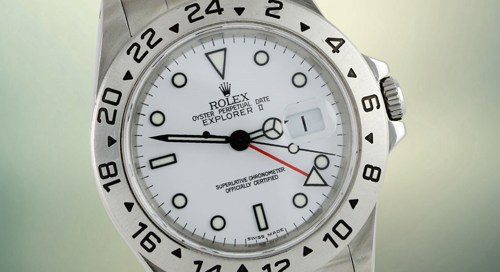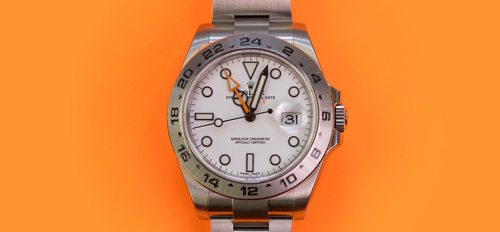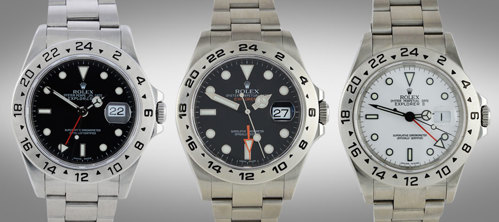Rolex
Close
Patek Philippe
Close
Close
The Rolex Explorer is one of Rolex’s most popular and iconic models. Rolex expert, David Duggan, takes an in-depth look at exactly what makes this watch so special and enduringly popular.

An icon among Rolex’s purpose-driven watches, the Explorer was originally designed for – and with the assistance of – the world’s foremost adventurers, climbers and mountaineers. The aim? To create the ultimate explorer’s tool watch that could survive the roughest conditions, keeping perfect time at -50°C (-58°F) with 70% less oxygen than at sea level.
Following 20 years of research that involved testing of prototypes during polar, mountaineering and caving expeditions, Rolex’s Oyster Perpetual chronometer was worn by Sir Edmund Hillary, Sir John Hunt and Sherpa Tenzing Norgay, when they became the first people to summit Mount Everest in 1953, an expedition that Rolex sponsored. Later that same year, in honour of their achievement, Rolex launched the first Oyster Perpetual Explorer I (reference 6298). The world’s most intrepid adventurers have been relying on its robustness and precision accuracy ever since.
Featuring a highly-durable, stainless steel bracelet and new double-waterproofed winding crown with Twinlock system (one sealed zone inside the tube and one inside the crown), the Explorer was an eminently functional timepiece that could be depended upon in the thunderstorms and blizzards of the highest altitudes in the Himalayas. The white dial of the initial model was replaced by more-legible black with the release of the reference 6350. The watch also had large luminescent hour markers and characteristic three, six and nine numerals for easy reading in low light. Inside, it was powered by an 18-jewel, calibre 775, rhodium-plated automatic movement.

A few alterations have been made over the years. In 1959, the reference 1016 was the first Explorer to be marked ‘Superlative Chronometer Officially Certified’ on its black gloss dial, proving that it was accurate to -2/+2 seconds per day after casing, which is more than twice the required accuracy for a chronometer. It was also the first to feature minute marks that went to the very edge of the dial. It remained in production until 1989, making it the longest continually made Rolex model. Considered by many collectors to be the most iconic of the Explorers, it was also a favourite of James Bond author Ian Fleming. That same year, the reference 6610 included the watch’s depth indication printed in red on the dial and a new calibre 1030 movement, which meant a bubble back was no longer required.
In 1971, the Explorer II was introduced with a date display, additional orange arrow 24-hour hand and a fixed bezel with 24-hour graduations, enabling day to be distinguished from night (another useful feature for explorers and volcanologists).
In 1985, the Explorer II reference 16550, nicknamed the ‘Polar Explorer’ because of its optional white dial and hands, brought a larger case size of 40mm (the original had a diameter of just 36mm), a sapphire crystal and calibre 3085 movement. The new movement meant that the 24-hour hand could be adjusted independently from the traditional hour hand to point to a specific number on the 24-hour bezel, meaning it was now able to display a second time zone – ideal for the globetrotting adventurer. Rolex also revamped the dial to look similar to other sports models, with the famed Mercedes-style hands and the combination of triangular, round, and rectangular lume-filled hour markers. Interestingly, the white-dial model has become especially sought-after by collectors due to an issue with the paint, which, over time, turns into a creamy ivory colour. So, what is essentially a defect has actually made the watch more valuable.
Rolex launched another update in 1989, the reference 16570, with black outlines surrounding the round hour markers on the white dials rather than the more traditional white gold. This model was made for 22 years, during which Rolex changed the luminescent material a few times. First came tritium, then, in the late-1990s, it switched to Luminova and, finally, changed to SuperLuminova around 2000.
With the turn of the Millennium also came the introduction of Rolex’s Parachrom hairspring, which is 10 times more precise in case of shocks, resistant to extreme temperatures and unaffected by magnetic fields in gravity.

2010 saw the introduction of the Explorer as it exists today. The reference 214270 added solid end links to the Oyster bracelet and updated the movement to the modern calibre 3132 ̶ considered to be the most accurate on the market, whereby the movements of your body power the watch, which has a power reserve of 48 hours. Another notable difference to its predecessors is a shorter handset (the minute hand does not reach the minute track).
Updated most recently for Baselworld 2016, today’s Explorer comes with a 39mm case, black dial featuring Rolex's proprietary Chromalight lume markers which glow blue in the dark, and a refreshed handset that is both longer and thicker. Inside, the Paraflex shock absorber ensures the calibre 3132 movement is resistant to any form of shock.
This hardy timepiece remains the watch of choice for climbers and explorers the world over, but you don’t have to scale a summit or trek to the poles to really appreciate the Explorer. Indeed, its meticulous quality and sporty design have won it many high-profile fans over the years – from movie stars (Steve McQueen, Tom Hanks, Orlando Bloom) to music makers (Bryan Ferry, John Mayer, Adam Levine) and even royalty (Prince Harry wore one while serving in the British Army).
The Explorer is one of the cheapest Rolexes to buy new and probably one of the best value on the used watch market. Given its rich history, and the fact that its design has barely altered in its 65+-year history, both vintage and newer models are highly prized among collectors. A pre-owned model today is worth more than double the official sales price from back in early-1990s, with some achieving steep prices. For example, in August 2019, a 1954 Oyster Perpetual Explorer sold for an impressive £31,900 at auction, more than five times its estimate.
In short, says David Duggan: “The Explorer I is a fantastic timepiece to kickstart the novice enthusiast’s collection, especially for anyone looking for an archetypal Rolex watch with a classic, understated design. Plus, it retains its value well.” Indeed, David puts this model at number one in his recommendations for choosing your first five Rolexes. The Explorer truly is an iconic watch that perfectly represents man’s ability to push boundaries and accomplish feats that were once thought impossible.
We regularly have a variety of Rolex Explorers available in the showroom, so if you’re interested in buying or selling one of these iconic timepieces, please contact David Duggan Watches to make an appointment.